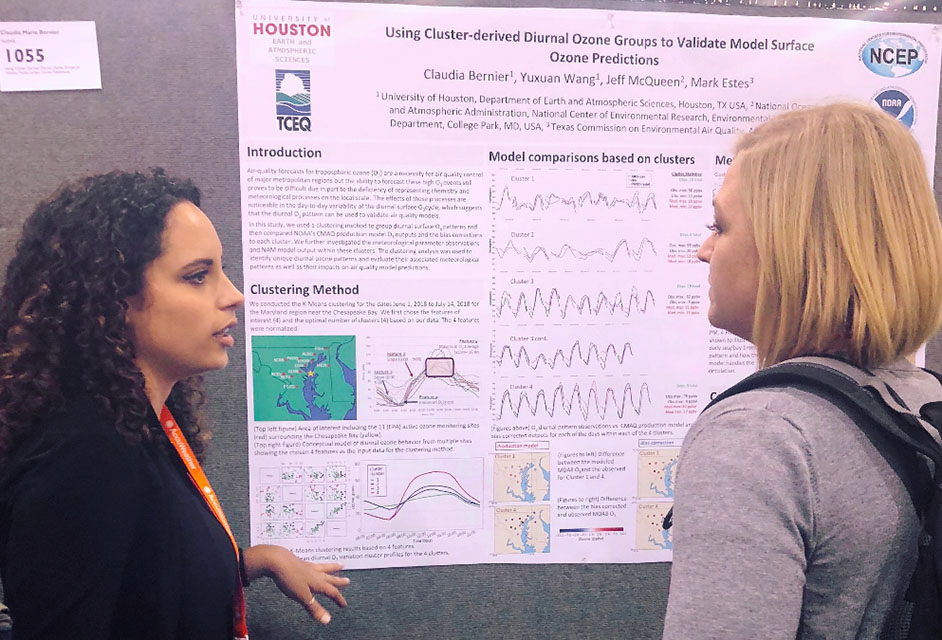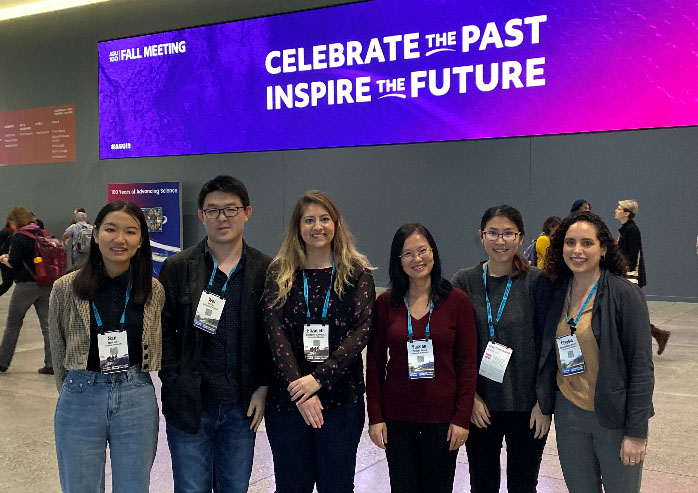Ph.D. Student Claudia Bernier Shares Experiences in EAS Department
When I started my UH EAS journey in summer 2017, I started on the master’s degree path with EAS professor Dr. Yuxuan Wang. Under her mentorship, I applied and was awarded a 2018 summer internship at the National Oceanic and Atmospheric Administration’s National Center of Environmental Prediction (NCEP) supervised by a mentor, Jeff McQueen.

At NCEP, I applied the research I had begun in my first year and evaluated a coastal ozone model (EPA CMAQ) near the Chesapeake Bay. Later in the year, I attended my first conference, the annual American Meteorological Society (AMS) meeting, to present the NCEP internship results which inspired me to change to the Ph.D. program.
As a Teaching Assistant for Introduction to Climate Change and Atmospheric Chemistry courses, I learned invaluable skills from the late Dr. Robert Talbot. Through my UH advisor, I conducted field work in 2019 with Dr. Alex Guenther from the University of California, Irvine, where we collected novel isoprene measurements from Houston trees.

Shortly after, I applied to the Ralph Cicerone Fellowship and interned at the National Center of Atmospheric Research Atmospheric Chemistry Observations and Modeling Division where I learned to run the WRF-Chem model with Dr. Gabriele Pfister as my mentor. In November 2019, I published a first-author manuscript in the Journal of Geophysical Research: Atmospheres. In this work, we developed a method to cluster diurnal patterns of ozone in the Houston-Galveston-Brazoria region and explained the clusters using associated meteorological patterns.
UH prioritizes the outreach of STEM for minority groups which gave us the opportunity to apply in Fall 2019 for the NASA Minority University Research and Education Project and Aeronautics Research Mission Directorate Fellowship. I was accepted for this three-year fellowship which has allowed me to work directly with the NASA Langley Mobile Lidar group and mentors Drs. Guillaume Gronoff and Timothy Berkoff.

Along with the efforts of my UH and NASA advisors, I published my second first-author manuscript in the journal Atmospheric Chemistry and Physics in December 2022. In this work, we developed a novel method to cluster multidimensional ozone lidar curtain profiles to characterize coastal tropospheric ozone during highly polluted summer months, which provided an approach to evaluate biases of widely used air quality models. I also participated in the September 2021 Tracking Aerosol Convection interactions ExpeRiment – Air Quality (TRACER-AQ) campaign, where I helped launch ozonesondes around the Houston region. In August 2022, I also visited NASA Langley, where I learned to operate lidar for ozone measurement.
While at UH, I attended multiple conferences that allowed me to network and learn from some of the brightest scientists around the world. At the most recent annual AMS conference, I was awarded the Outstanding Student Presentation Award from the 2023 AMS 25th Conference on Atmospheric Chemistry for recent work in which we are evaluating the WRF-Chem model capabilities during the TRACER-AQ campaign alongside lidar-derived curtain profiles of ozone.
I am very grateful and fortunate for the past six years at UH and for my advisor Dr. Yuxuan Wang for guiding and supporting me through my degree. I plan to graduate soon and hope to continue my research in coastal tropospheric ozone development using air quality modeling and ozone lidar instruments in the NASA postdoctoral program. I plan to take all I have learned from the UH EAS department into my future career.
